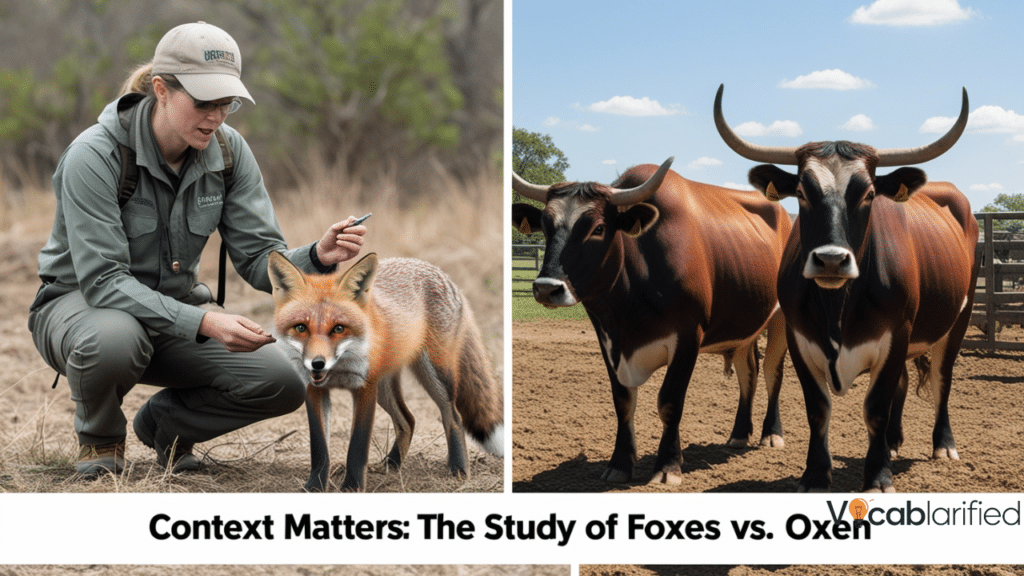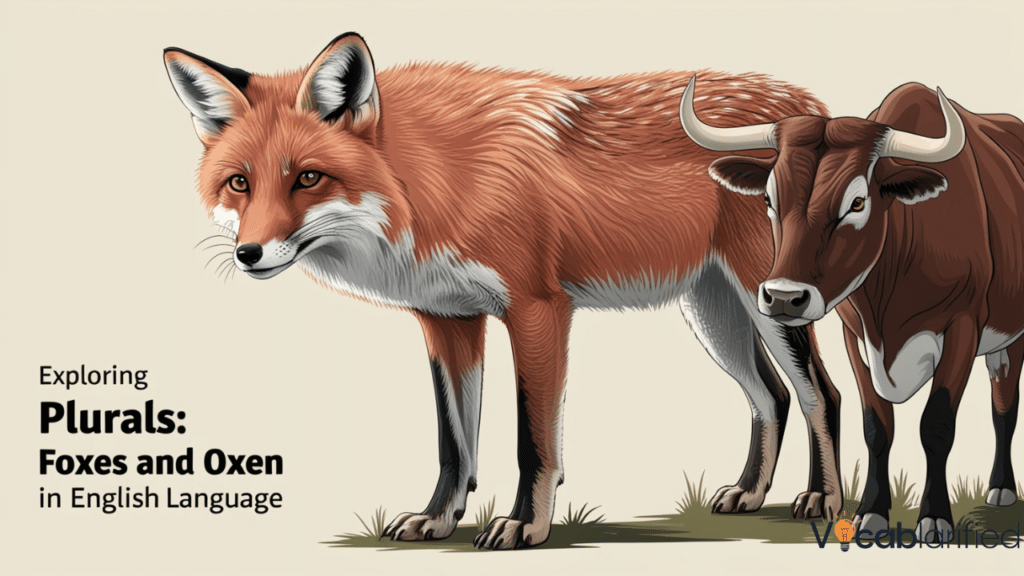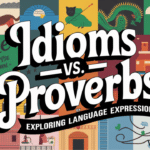The English language is a complex tapestry of linguistic nuances that often leaves learners and native speakers alike scratching their heads.
Among the most intriguing aspects of this rich linguistic landscape are the various ways words transform when shifting from singular forms to their plural counterparts. Today, we’ll embark on a linguistic journey exploring the pluralization of two seemingly simple words: fox and ox.
Historical Linguistics Behind Word Transformations
Pluralization rules in English are not always straightforward. While many words simply add an ‘s’ to become plural, some words follow unique patterns that trace back to the depths of Old English. The words fox and ox exemplify these fascinating linguistic exceptions that challenge our understanding of standard grammar rules.
The Fox | A Tale of Pluralization
Tracking the Fox Through Linguistic History
The word fox presents an interesting case in English grammar. Most English nouns follow a relatively simple rule of adding an ‘s’ to create their plural form. Hence, foxes becomes the standard plural representation. This transformation reflects the language’s tendency to maintain phonetic integrity while creating plural versions of words.
Email Scenario: Professional Communication
Consider an email from a wildlife researcher, Dr. Emily Richardson, to her colleague:
Subject: Fox Population Study
Dear Dr. James Anderson,
I'm writing to report our recent findings on **foxes** in the Appalachian region. Our team has tracked multiple **fox** populations across different habitats...In this scenario, the writer seamlessly uses both singular and plural forms, demonstrating the natural flow of animal terminology in professional communication.
You Might Like: Up to Date or Up-to-Date | Which One Should You Use?
Table of Fox Linguistic Variations
| Singular | Plural | Context of Use |
|---|---|---|
| Fox | Foxes | Standard English |
| Fox | Fox (rare) | Collective reference |
| Fox | Foxen (archaic) | Historical usage |
| Fox | Foxes | Scientific writing |
| Gray fox | Gray foxes | Specific species |
| Red fox | Red foxes | Zoological reference |
| Arctic fox | Arctic foxes | Geographic variation |
| Kit fox | Kit foxes | Subspecies |
| Swift fox | Swift foxes | Species identification |
| Fennec fox | Fennec foxes | Exotic species |
Linguistic Evolution of Fox
The transformation from fox to foxes represents a standard pluralization process in modern English. Unlike some irregular plurals, this word follows a predictable pattern of adding ‘es’ to words ending in certain consonant sounds.
The Ox: A More Complex Pluralization Journey
Ox in Language Evolution
The word ox presents a more complex pluralization challenge. Unlike most animals, ox does not simply add an ‘s’ to become plural. Instead, it transforms into oxen, a remnant of Old English linguistic structures that have survived into modern times.
Professional Correspondence Example
A veterinary supply company might use the term in a professional email:
Subject: Livestock Equipment Order
Dear Sarah Thompson,
We've prepared a comprehensive catalog of equipment for managing **oxen** in large agricultural settings. Our latest models are specifically designed for **ox** handling...Table of Ox Linguistic Contexts
| Singular | Plural | Usage Scenario |
|---|---|---|
| Ox | Oxen | Traditional usage |
| Ox | Oxes (rare) | Informal contexts |
| Ox | Ox (collective) | Specialized references |
| Work ox | Work oxen | Agricultural context |
| Draft ox | Draft oxen | Historical terminology |
| Wild ox | Wild oxen | Zoological description |
| Water buffalo ox | Water buffalo oxen | Specific species |
| Domestic ox | Domestic oxen | Farming terminology |
| Yoke ox | Yoke oxen | Historical agricultural use |
| Breeding ox | Breeding oxen | Livestock management |
You Might Like: Understanding How “Run” Changes in the Past and Past Participle
The Linguistic Significance of Oxen
The term oxen represents a grammatical rule that has persisted through centuries of linguistic change. This irregular plural form connects modern English speakers to their linguistic ancestors, preserving a piece of historical linguistics in everyday language.
Diving Deeper into Word Endings
The Scientific Perspective on Pluralization Rules
Language peculiarities often reveal themselves most clearly when examined through a scientific lens. The transformation of fox and ox into their plural forms provides a fascinating window into the intricate mechanisms of English grammar. These words represent more than mere grammatical curiosities; they are living artifacts of linguistic evolution.
Academic Exploration of Linguistic Exceptions
Professors and linguists continuously marvel at the complex ways languages develop and maintain their unique characteristics. Dr. Rebecca Hartmann, a renowned linguist, might explain this phenomenon in a professional communication:
Subject: Research on Irregular Plurals
Dear Colleagues,
Our latest study explores the fascinating world of **irregular plurals** in English, with particular focus on words like **fox** and **ox** that challenge standard pluralization conventions...You Might Like: Afterward or Afterwards | Is There Any Difference?
Table of Linguistic Morphology
| Linguistic Feature | Fox | Ox | Explanation |
|---|---|---|---|
| Original Etymology | Germanic | Old English | Historical roots |
| Standard Plural | Foxes | Oxen | Typical transformation |
| Phonetic Change | Minimal | Significant | Sound modification |
| Usage Frequency | Common | Specialized | Contextual prevalence |
| Grammatical Category | Animal | Livestock | Semantic classification |
| Linguistic Complexity | Low | High | Pluralization difficulty |
| Regional Variations | Minimal | Moderate | Geographical influences |
| Academic Interest | Moderate | High | Linguistic research value |
| Morphological Pattern | Regular | Irregular | Pluralization type |
| Cultural Significance | Symbolic | Practical | Linguistic context |
Exploring Phonetic Integrity
The concept of phonetic integrity plays a crucial role in understanding how words transform. When a word becomes plural, it undergoes subtle or dramatic changes that preserve its essential sound and meaning. The journey from fox to foxes and ox to oxen demonstrates the delicate balance between linguistic preservation and evolution.
The Zoological Perspective
Animal Terminology in Linguistic Context
Zoologists and linguists share a unique intersection of interests when it comes to animal terminology. The ways we describe animals linguistically often reflect deeper cultural and historical connections. The plural forms of fox and ox provide rich ground for such interdisciplinary exploration.

Professional Communication Example
A wildlife conservation email might illustrate this point:
Subject: Species Population Report
Dear Dr. Michael Chen,
Our recent survey of **foxes** in the northern regions reveals fascinating population dynamics. The adaptation of **fox** species continues to surprise our research team...Table of Comparative Linguistic Analysis
| Language Feature | Foxes | Oxen | Comparative Notes |
|---|---|---|---|
| Plural Formation | Standard addition | Irregular change | Morphological difference |
| Sound Modification | Minimal | Significant | Phonetic transformation |
| Historical Origin | Germanic roots | Old English | Etymological background |
| Modern Usage | Widely accepted | Specialized | Contextual application |
| Grammatical Complexity | Low | High | Linguistic challenge |
| Writing Frequency | Common | Rare | Textual occurrence |
| Spoken prevalence | High | Moderate | Verbal communication |
| Academic Interest | Moderate | High | Scholarly research |
| Cultural Significance | Symbolic | Practical | Linguistic meaning |
| Linguistic Flexibility | Adaptable | Rigid | Morphological characteristics |
Language Evolution Unveiled
The transformation of fox and ox into their plural forms offers a microcosm of language evolution. Each shift represents a tiny chapter in the ongoing story of human communication, where words adapt, change, and persist through generations.
The Broader Linguistic Landscape
Understanding Grammar Rules
Grammar rules are never absolute; they are living, breathing guidelines that constantly reshape themselves. The plural forms of fox and ox demonstrate this principle perfectly. They challenge our understanding of linguistic consistency while simultaneously preserving historical linguistic patterns.
Scholarly Reflection
Linguists like Dr. Elena Rodriguez might argue that these linguistic nuances are more than mere grammatical curiosities. They are windows into human cognitive processes, reflecting how we categorize, understand, and communicate about the world around us.
Conclusion: A Linguistic Journey
The exploration of fox, oxen, and their linguistic cousins reveals the beautiful complexity of the English language. From the subtle shift of fox to foxes to the more dramatic transformation of ox to oxen, these words tell a story far beyond their simple definitions.
Each plural form carries within it a rich tapestry of historical, cultural, and linguistic significance. They remind us that language is not a static set of rules, but a dynamic, living entity that continues to evolve, surprise, and delight those who take the time to explore its intricate depths.

Emma Carter is an experienced blogger at Vocablarified. She enjoys helping people expand their vocabulary and improve their language skills. With a warm and approachable writing style, Emma makes learning new words fun and accessible. When she’s not writing, she loves reading books and discovering new phrases to share with her readers. Emma is passionate about making language learning an enjoyable journey for everyone.







